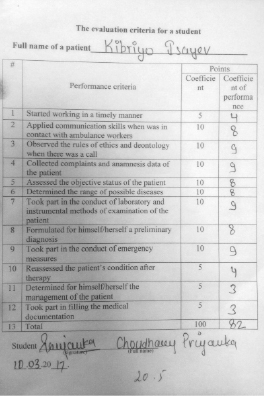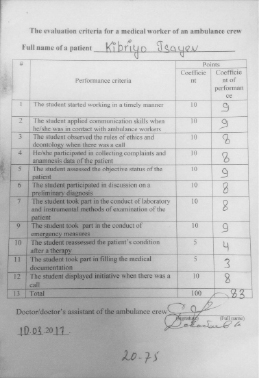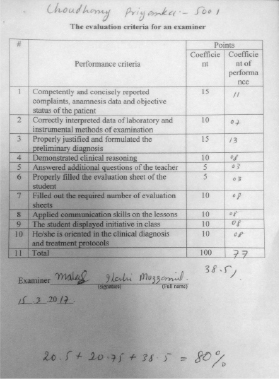The current situation in health care requires reforming the system of medical education, making new demands for the training of highly qualified professionals [1].
In according to modern requirements, there has been a need to initiate new methods of control, including such concepts as systemic, measurable results, objectivity of their evaluation, unification, manufacturability and reliability [2].
Clinical skills education in the undergraduate medical curriculum is fundamental to the development of basic clinical method and the lifelong achievement of excellence in clinical practice [3, 8].
Clinical studying process is proceeded by basic clinical skills curriculum enhancement required in emergency medical care.
Evaluation of the curriculum must not be overlooked, as it is a crucial component of successful curriculum implementation and efforts for continuous quality improvement of a curriculum over time. Done well, it provides essential information to guide learner’s curriculum planners, faculty, and other stake holders such as those who allocate resources [4, 5, 6, 9, 10].
Learning around a patient helps to convey a holistic approach to medical care that combines the necessary knowledge, clinical skills and attitudes [7].
The additional benefit of an actual clinical setting is that it allows for procedure performance within clinical context including observation of student professionalism, and their ability to communicate with and provide comfort for the patient.
The purpose of our research is to report the teaching process and review concerning with foreign medical students that how they are learning particularly theoretical, practical and clinical based skills by applying innovative methods and further monitoring the student’s progress and evaluation of their clinical knowledge by specific assessment and examination procedure.
During the course “Ambulance and Emergency medical care” the foreign students must learn the theoretical material, in particularly, identification, risk factors, guidelines for syndromic diagnosis and emergency at a prehospital stage indication for hospitalization, transportation conditions; to form skills in providing emergency care in an epidemic outbreak, in emergencies and disasters; to obtain practical skills working with physicians on emergency calls and in a hospital receptionist.
Learning to perform basic and common clinical procedures enables the student not only to understand and perform required clinical procedures, but also to begin to develop confidence and competence at a more advanced level of patient-doctor relation and communicative skills.
Implementation of curriculum development can be preceded by emergency calls and in a hospital receptionist, the student’s participation in a clinical analytical sessions, and analysis of repeat station calls that can be related with sudden death or severe unconsciousness condition. Discussion about differential diagnoses medical card calls (form 110/u) and medical records in hospitals, the usage of communication skills to create an atmosphere of trust between patient and doctor and to obey the orders of establishment of ambulance services.
During the course “Ambulance and Emergency medical care”, the foreign students work on specialized cardiac, neurological, paramedic ambulance crews, in emergency control station, study the principles of disaster medicine, managing the medical records of ambulance and emergency care service.
For foreign students, in practical classes objective priority is that to focus the related topics under specific protocol for the purpose, in every practical class, discussion about related topics are preceded on urgent diagnostics and treatment.
In the respective field of emergency medicine the most important act is the concerning knowledge and time duration; that how in short time we can diagnose and treat the patient on urgent ambulatory call. Additionally, in self-individual work with teacher, they are advised to solve concerning topic tasks about clinical situations. In the duration, teacher’s approaches to clarify the concerning tasks by which students can deal any emergency situations. During the period, there are given duties by department in ambulances in different stations to understand and practice of clinical skills. Students are going to ambulances with concerning staff including Emergency doctor or First aid man and nurse.
Students are advised by teacher to do physical examination for purpose of urgent diagnose by apply their clinical skills to treat the patient urgently.
Next day of ambulance duty teacher is asking about their work experience or progress; in that time asking about complaints, condition of patients and how student checked the patients and about student’s observations during clinical propaedeutic or physical examination; at last, student’s strategy in a very short period to diagnose and treatment of patient.

Fig. 1. The evaluation criteria for a student
General disadvantages: during practical classes, has been observed language barrier of some foreign students on occasion of communication with crew and patients. The attitude and behaviour of crew of station are not so obligatory for foreign students. In ambulances the some doctors not allowed them to check the patients and not showed them practical skills (in form of electrocardiogram (ECG), glucometer results, sphinomanometer results).
The practical classes are mandatory for all students, including the foreign students.
During the period of studying the discipline in addition of practical lessons, the foreign students obtain practical knowledge in Centre of Practical Skills (CPS) of Karaganda State Medical University, like that cardiopulmonary resuscitation, in particularly the technique of chest compressions, methods of artificial respiration “by mouth to mouth”, by mask, Ambo, and defibrillation technique; registration and interpretation of ECG; emergency assistance in cardiogenic shock, traumatic shock, relief of bronchial obstruction, hypertensive crises, hypoglycaemic states.
At the practical classes on the ambulatory call, in CPS, the foreign students have to be able to show the basic principles of diagnosis of emergency conditions, to render the first medical assistance for various emergency conditions and to improve skills of interpersonal communication and consultation of patients.
At the mid of practical lesson or at the last main control examination has been conducted in form of multiple choice questions (MCQS) to assess their performance while one mini-clinical exams is taken at the end of practical classes, its purpose is to do assessment individually of their clinical knowledge and skills; during mini-clinical exam, every steps have contain specific marks.

Fig. 2. The evaluation criteria for a medical worker of an ambulance crew

Fig. 3. The evaluation criteria for an examiner
Mini-clinical exam held during the learning process. It is estimated in accordance with the 3 check lists: of medical workers, students and teachers (fig. 1, 2, 3).
Mini clinical examination, which is held at the Department of Ambulance and Emergency Medical Care #1, stimulates students to learn practical skills well, due to the fact that the students start to understand that practical skills are important part of the work in practical public health.
About evaluation of practical skills: in 2016 academic year, students of foreign department showed following results: marks of mini-clinical exam compiled 87,3 %; work of CPS – 87,8 %.
Conclusion
The foreign medical students are conveyed the all required aspects of theory and practical clinical skills on the basis of innovative methods of clinical skills assessment. There is conducted specific examination process to evaluate students that are declared their success according to their performance. Successful graduates can be beneficial for their clinical professional practice in the field of medicine.
Библиографическая ссылка
Alpyssova A.R., Ilahi M. CLINICAL PRACTICE AND INNOVATIVE METHODS OF STUDENT’S PROGRESS EVALUATION // European Journal of Natural History. 2017. № 5. С. 56-60;URL: https://world-science.ru/ru/article/view?id=33806 (дата обращения: 07.01.2026).

